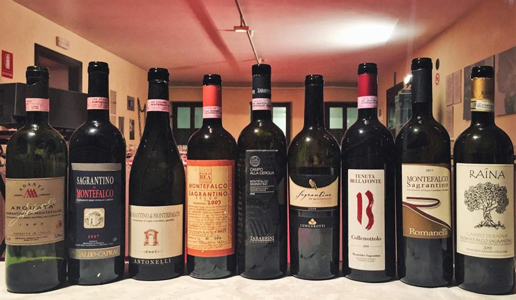Montefalco stands the test of time with character

An instructive retrospective of Montefalco Sagrantino from different vintages and producers over a period from 1995 to 2013.
If there is a wine that has divided the opinions of wine critics and wine lovers it is Sagrantino. It is a wine that is very appreciated but rarely loved by a vast number of consumers and equally viewed with warmth, when it is not snubbed, by an equal number of people. In the 1990s, when the national tastes were more for wines with extracts, Sagrantino was in the limelight for being an esthetic model thanks to its bold polyphenolic properties.
Looking back, the massive promotional campaign by the Caprai estate had a very positive effect throughout Italy. Somewhat like what occurred for Franciacorta thanks to Ca’ del Bosco and Bellavista.
Some mysteries remain about this wine which by regulation does not use Sangiovese, which in this area produces excellent results, and yet considers tannins to be the wines one and only strongpoint.
For this and other reasons we were very interested in the tasting Sagrantino over time, yesterday and today, a vertical sampling of vintages from 2013 back to 1995, which includes some peak years. It was impeccably organized and led, during the last Ein Prosit, by our Umbrian colleague Jacopo Cossater, who has studied the area for years, and helped to resolved some of my personal doubts about certain wines beyond expectations. The tannins in all the wines, for example, were settled, an indication that bottle aging allowed them to peak. Like with all the greatest red wines, bottle aging lessened the influence of winemaking techniques, which over time have become secondary to the characteristics of the terroir and the varietal.
“Montefalco as we know it today was created by entrepreneurs from other fields, like Adanti and Caprai, who led the way for historic producers,” Cossater explained. In recent years, large barrels have for the most part replaced the classic small ones for maturing the wine, while some producers are focusing on subzones. But this is still in the initial stages for an appellation that is geologically and geographically quite uniform and uses a varietal that does not easily bend to expressing micro variations of climate and terroir.
The average quality level of the wines offered at the tasting was very high and confirmed the need to let them age in the bottle for at least a decade. There is also no doubt that even with long bottle aging Sagrantino remains a wine for the mouth, characterized as it is by a flavor that is as broad as it is solid while the aromatic persistence, bold as it may be, does not add my other scents other than those in the bouquet.

 Italiano
Italiano
























